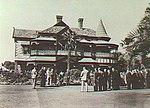Mary MacKillop College, Kensington
Mary MacKillop College is a Catholic girls secondary school in the Adelaide suburb of Kensington. The Josephite sisters have been providing Catholic education in Kensington since 1872 six years after the order was founded by Mary MacKillop, who lived in the Kensington district for eleven years. Since then several sites in the area have been used as schools; the current secondary college developed out of a "cottage school" on the grounds of the convent across the road.Mary MacKillop College educates students from Year 7 to Year 12. Middle school students (Years 7, 8 and 9) study compulsory courses across eight key learning areas. Senior students are allowed greater flexibility in their studies from Year 10 and undertake studies towards the South Australian Certificate of Education in Years 11 and 12. Senior students are also able to undertake Vocational Education and Training courses.Mary MacKillop College is a member of the South Australian Catholic Girls Sports Association and the South Australian Secondary Sports Association, and students from the College participate in a variety of team and individual sporting competitions. Students are also able to participate in various cultural, liturgical and community activities.In 2010 there were 537 students enrolled at the school. In 2015 there were 320. In 2020, there were 406 students enrolled at the school, across years 7 to 12.
Excerpt from the Wikipedia article Mary MacKillop College, Kensington (License: CC BY-SA 3.0, Authors).Mary MacKillop College, Kensington
Phillips Street, Adelaide Kensington
Geographical coordinates (GPS) Address Nearby Places Show on map
Geographical coordinates (GPS)
| Latitude | Longitude |
|---|---|
| N -34.922884 ° | E 138.642765 ° |
Address
Mary McKillop College
Phillips Street
5068 Adelaide, Kensington
South Australia, Australia
Open on Google Maps



